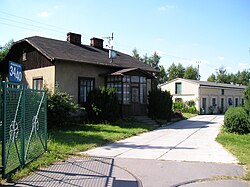Krasnowola
Krasnowola | |
|---|---|
 Buildings at Krasnowolska Street in Krasnowola, in 2019. | |
 | |
| Coordinates: 52°08′33″N 20°59′57″E / 52.14250°N 20.99917°E | |
| Country | |
| Voivodeship | Masovian |
| City and county | Warsaw |
| District | Ursynów |
| City Information System area | Grabów |
| Time zone | UTC+1 (CET) |
| • Summer (DST) | UTC+2 (CEST) |
| Area code | +48 22 |
Krasnowola is a neighbourhood in Warsaw, Poland, located within the district of Ursynów, in the City Information System area of Grabów. It is centred around Krasnowolska Street, and mostly consists of single-family detached homes.[1][2][3]
The village of Krasnowola was founded in the 19th century, to the southeast of Grabówek.[4] In the second half of the century, the Krasnowola Manor House[5] was constructed. In 1951 the area was incorporated into Warsaw.[6]
History

The village of Krasnowola was founded in the 19th century, to the southeast of Grabów, around current Krasnowolska Street.[4] In the second half of the 19th century, in Krasnowola, at current 78 Krasnowolska Street, was built the Krasnowola Manor House, which then became the residence of castellan Kretkowski.[5]
On 8 September 1939, Krasnowola was captured by the German forces during the Invasion of Poland in the Second World War.[7]
On 14 May 1951, Krasnowola was incorporated into the city of Warsaw.[6]
In 1998, the district of Ursynów was subdivided into the areas of the City Information System, with Krasnowola becoming part of the area of Grabów.[8][9]
Characteristics

Krasnowola is located in the southwestern portion of the City Information System area, within the district of Ursynów. Its centred around Krasnowolska Street, and mostly consists of single-family detached homes, and a small portion of it also includes farmlands.[1][2]
In the neighbourhood, at 78 Krasnowolska Street, is the Krasnowola Manor House, a historical residence build in the 19th century,[5] and near Krasnowolska Street and Poloneza Street is Zabłocki Lake.[10][11]
References
- ^ a b Studium uwarunkowań i kierunków zagospodarowania przestrzennego miasta stołecznego Warszawy ze zmianami. Warsaw: Warsaw City Council, 1 March 2018, pp. 10–14. (in Polish)
- ^ a b "Państwowy Rejestr Nazw Geograficznych – miejscowości – format XLSX". dane.gov.pl (in Polish).
- ^ "Obszary MSI. Dzielnica Ursynów". zdm.waw.pl (in Polish).
- ^ a b Barbara Petrozolin-Skowrońska (editor): Encyklopedia Warszawy, vol 1. Warsaw: Wydawnictwo Naukowe PWN, 1994, p. 275. ISBN 9788301088361. (in Polish)
- ^ a b c "Najpiękniejsza willa na Ursynowie! Odzyska dawny blask?". haloursynow.pl (in Polish). 8 June 2023.
- ^ a b "Rozporządzenie Rady Ministrów z dnia 5 maja 1951 r. w sprawie zmiany granic miasta stołecznego Warszawy". isap.sejm.gov.pl (in Polish).
- ^ Jacek Krawczyk: Ursynów wczoraj i dziś. Warsaw: Wydawnictwo Pagina, 2001, p. 61. ISBN 83-86351-37-3. (in Polish)
- ^ "Uchwałą Nr 563 Rady Gminy Warszawa-Ursynów z dnia 18 czerwca 1998 r. z późniejszymi zmianami z dnia 18 czerwca 1998 r. w sprawie wprowadzenia Miejskiego Systemu Informacji w Gminie Warszawa-Ursynów" (PDF). zdm.waw.pl (in Polish).
- ^ "Uchwała Nr 366 Zarządu Gminy Warszawa-Ursynów z dnia 9 lutego 2000 r. w sprawie uzupełnienia i skorygowania Miejskiego Systemu Informacji w Gminie Warszawa-Ursynów" (PDF). zdm.waw.pl (in Polish).
- ^ "Załącznik tekstowy i tabelaryczny do programu ochrony środowiska dla miasta stołecznego Warszawy na lata 2009–2012 z uwzględnieniem perspektywy do 2016 r." (PDF). bip.warszawa.pl (in Polish). 21 October 2010.
- ^ Jacek Skorupski (May 2013). "Projekt miejscowego planu zagospodarowania przestrzennego zachodniego pasma pyrskiego w rejonie ul. Poleczki położonego w dzielnicy Ursynów i Włochy miasta stołecznego Warszawy. Prognoza oddziaływania na środowisko" (PDF). bip.warszawa.pl (in Polish).

